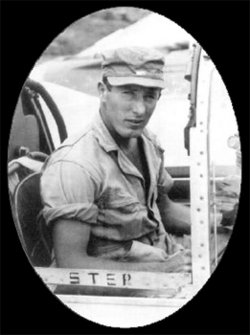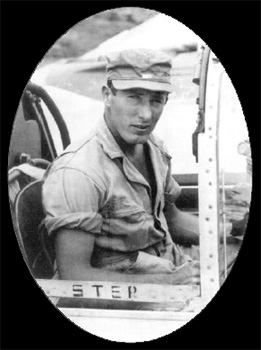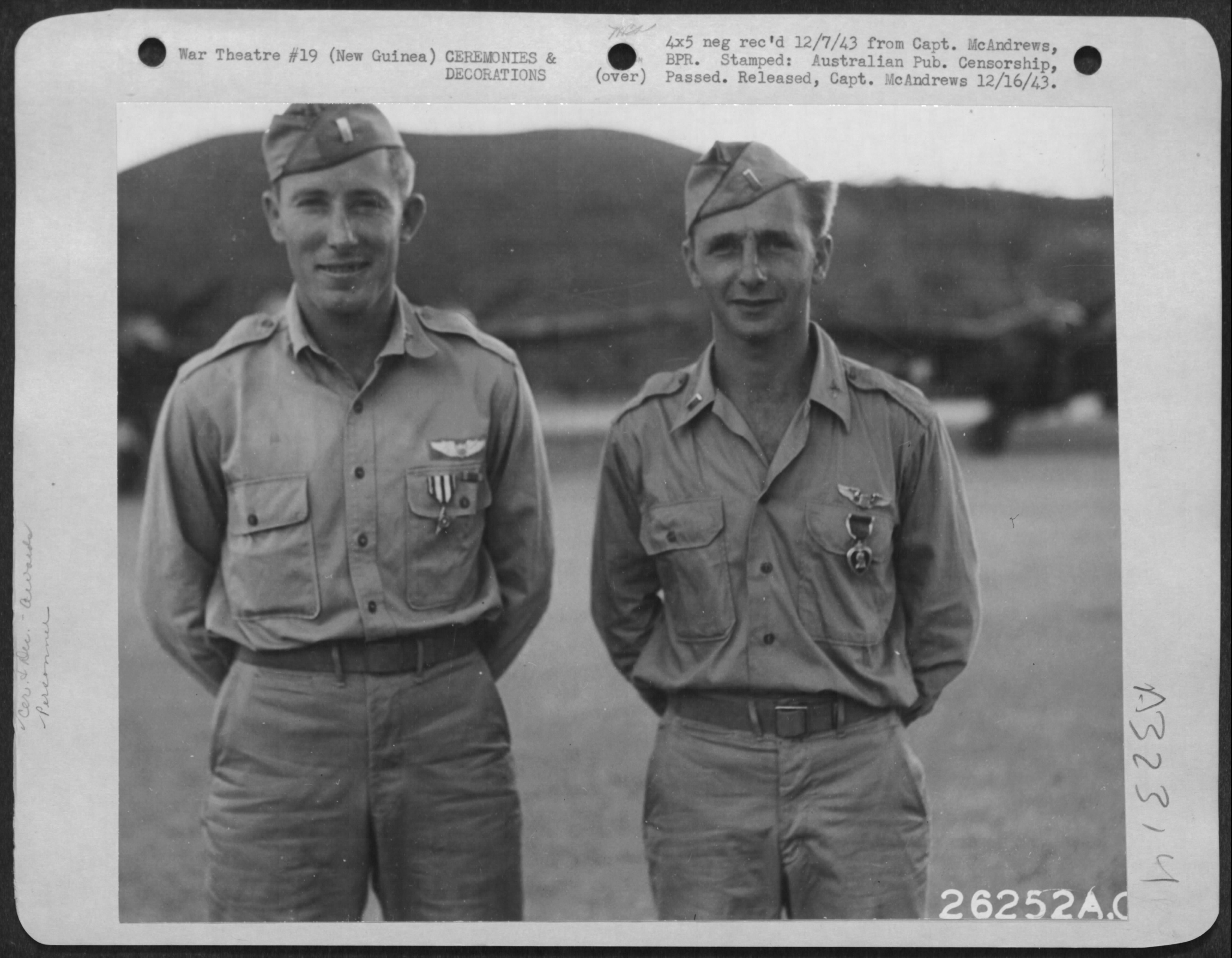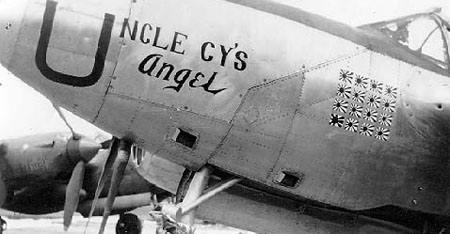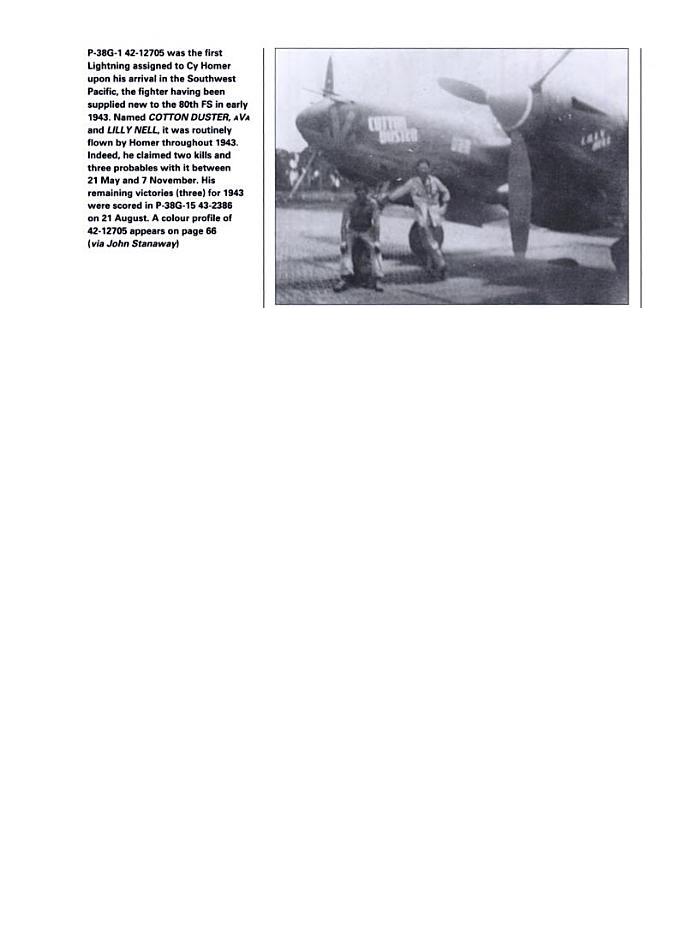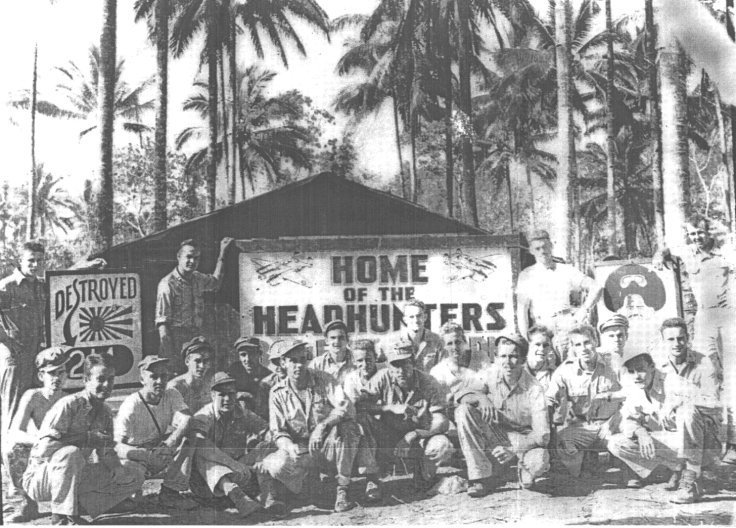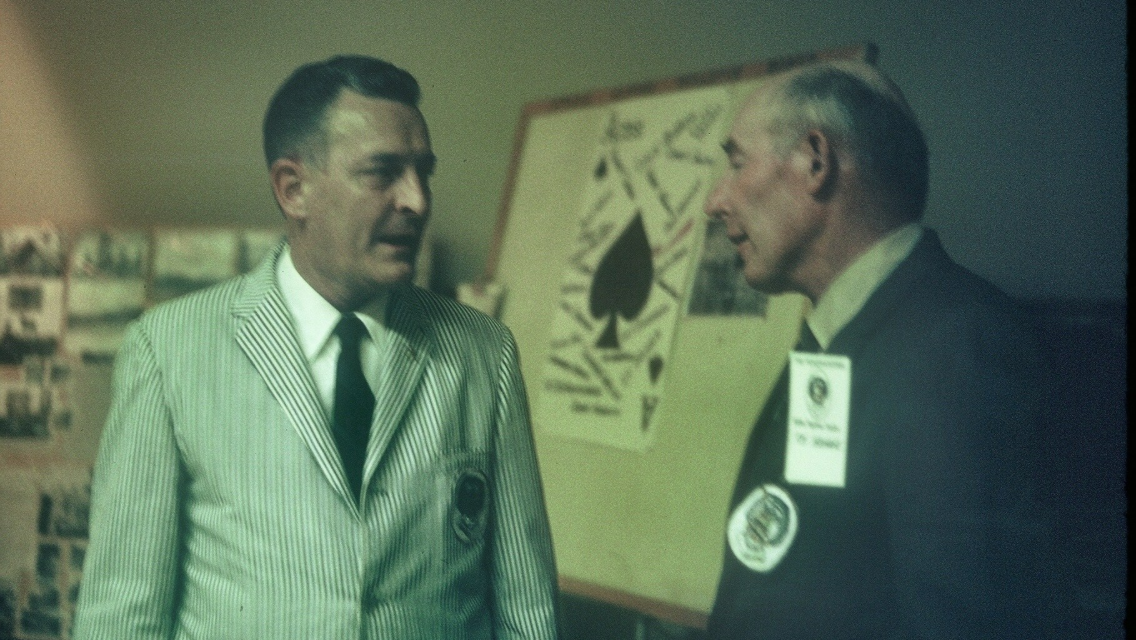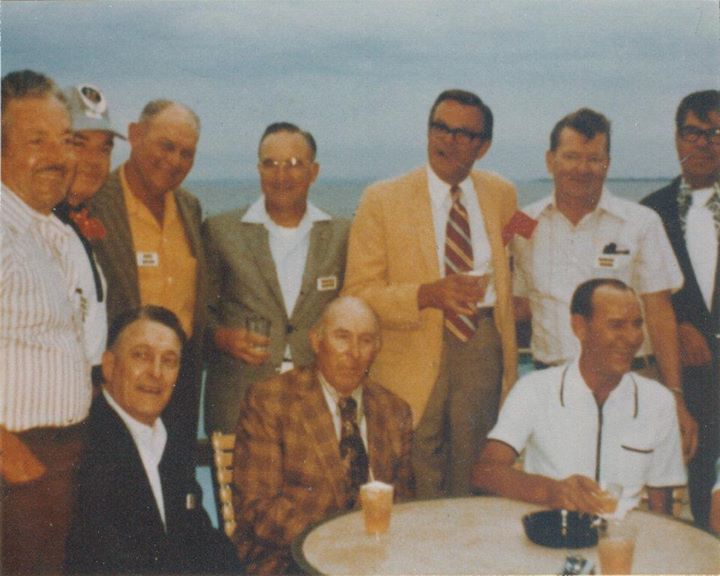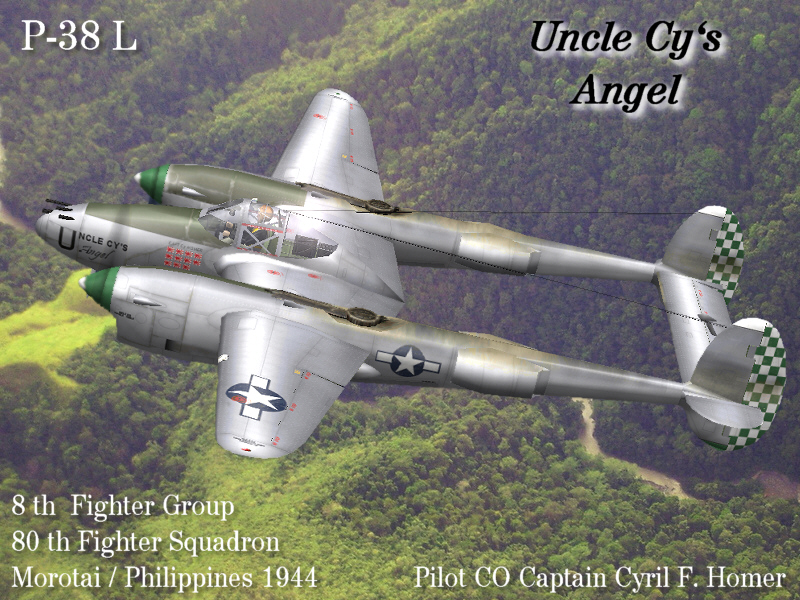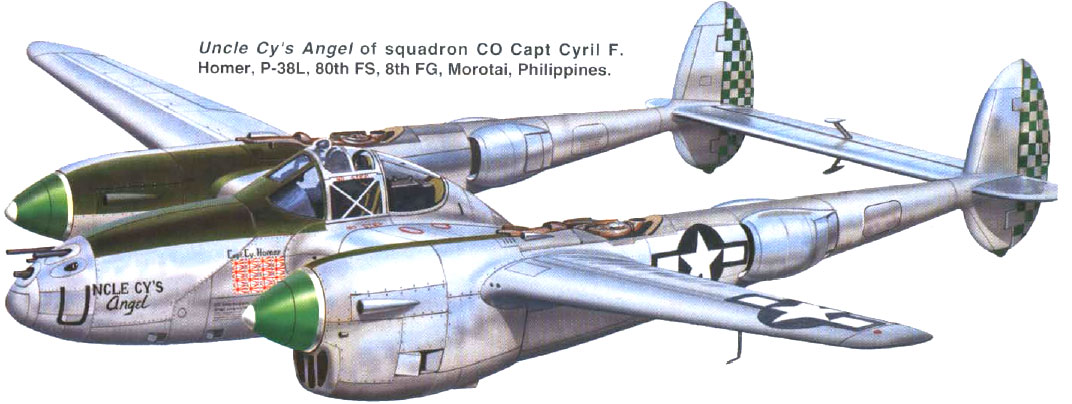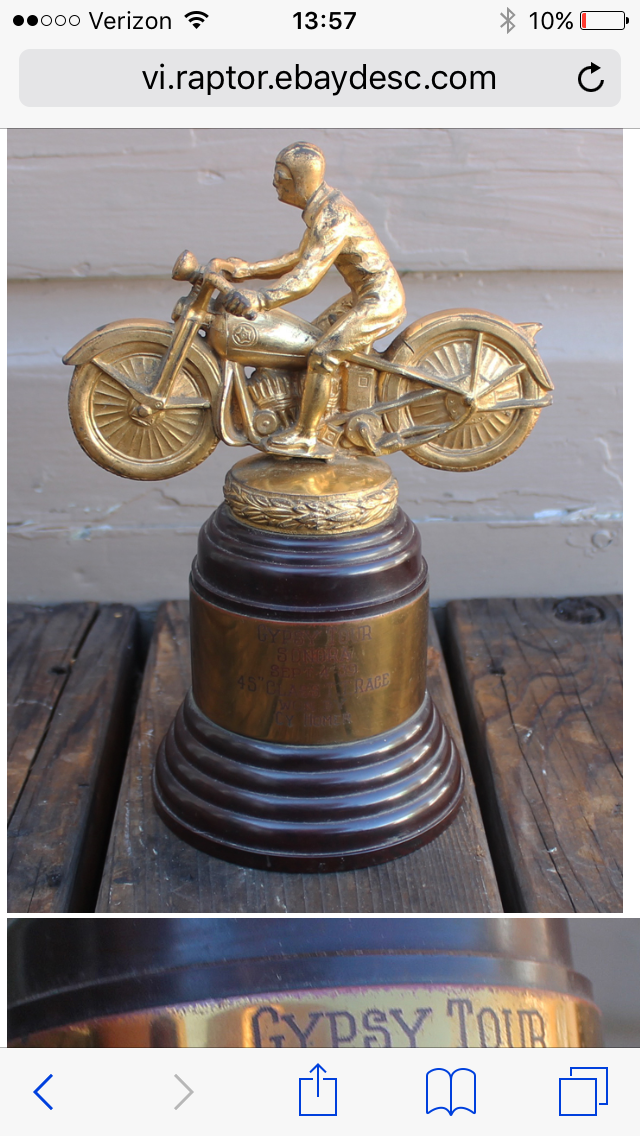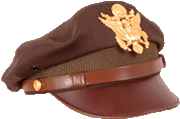~~~~~~~~~~~~~~~~~~~~~~~~~~~~~~~~~~~~~~~~~~~~~~~~~~~~~~~~~~~~
Cyril attended San Juan Union High School in Fair Oak, California in the same class as his cousin Jeanne Filcher Delmar. His service enlistment date is Feb. 18, 1941 at San Francisco. Military records show he had two years prior college experience before enlisting. His military aviation record is noted in numerous books and articles. He married Noelene Valerie Eedy, in 1944, in the District of Sidney, Australia. Cyril's post military life is mostly a mystery. The 1949 Sacramento City Directory list Cyril and Noelene living at rural route 7, box 3822, with his occupation listed as salesman at Motor Cycle Service Shop. His cause of death at the rather young age of 56 years is also unknown. His burial location is unknown but it is assumed to be somewhere in the Sacramento area since this is where he passed away or possibly at a national veterans cemetery.
Family records show that Cyril and Noelene had two children:
1)Deborah Homer
2)Neil L. Homer
The Filcher family tree information ends with the above information. Perhaps Deborah and Neil will read this one day and choose to add to their parents' story.
~~~~~~~~~~~~~~~~~~~~~~~~~~~~~~~~~~~~~~~~~~~~~~~~~~~~~~~~~~~~
Cyril Homer was born April 29, 1919 in West New Jersey, New Jersey. He joined the Army Reserve and qualified as pilot Lieutenant October 30, 1942 at Luke Field, Arizona. In late January 1943, he logged 272 hours of which 226 hours were flight training. Assigned to the 80th Fighter Squadron / 8th Fighter Group in February 1943, he assumed command of the 80th Fighter Squadron from 4 October 1944 to 9 May 1945, leaving the Group on May 25. When leaving the unit, his hunting board had 15 victories(Triple Ace) over Rabaul, Wewak and Hollandia. These many victories have earned him the award of a Distinguished Service Cross, the Silver Star and three DFC and Air Medal 10.
~~~~~~~~~~~~~~~~~~~~~~~~~~~~~~~~~~~~~~~~~~~~~~~~~~~~~~~~~~~~
HOMER Cyril Filcher "Cy" "Uncle Cy" (Maj) O-732248
Distinguished Service Cross
Silver Star
Distinguished Flying Cross (2 oak leaf cluster)
Air Medal (9 oak leaf cluster)
Asiatic-Pacific Campaign Medal
World War II Victory Medal
Promotion record:
2LT 10/1942
1LT 09/43
Cpt.07/44
Maj.11/44
~~~~~~~~~~~~~~~~~~~~~~~~~~~~~~~~~~~~~~~~~~~~~~~~~~~~~~~~~~~~
"Cy Homer of the 8th Group was really good—but he practiced a lot. I used to see him out practicing when I was slow-timing an engine or just flying around the area. He would do Immelmanns or something until he could do them perfectly.", from an interview with Joe Forster, fellow WWII P-38 Ace.
~~~~~~~~~~~~~~~~~~~~~~~~~~~~~~~~~~~~~~~~~~~~~~~~~~~~~~~~~~~~
The following is an excerpt from the book "'Twelve to One' V Fighter Command Aces of the Pacific", compiled by Tony Holmes as part of the 'Osprey Aircraft of the Aces-61 Special' first published in Great Britain in 2004 by Osprey Publishing. All rights to this information belong to Osprey Publishing Limited:
Cyril Filcher Homer was born on 29 April, 1919 in West New Jersey, New Jersey. Moving to the west coast as a youth, he attended the University of California before joining the Army Reserves. Homer then transferred to the Army Air Corps for flight training and graduated as a pilot from Luke Field, Arizona as part of Class 42-J on 30 October 1942. He transitioned onto the P-38 Lightning at Muroc Field (Later renamed Edwards), in California, and was then sent to the 80th FS/8th FG at Mareeba, in Queensland, Australia, in February 1943, just as the squadron was transitioning from the P-39 to the P-38. Homer's arrival raised some eyebrows amongst the battle hardened veterans of the 80th FS, including flight commander Norbert Ruff, who remembered thinking that that Army Air Force was scraping the bottom of the barrel by making a fighter pilot of this severe-looking man with a pronounced limp (just two years earlier an aviation cadet had to be in perfect physical shape). Homer had raced motorcycles pre-war until he had been badly injured in a crash. All reservations vanished, however, when Ruff saw the most unbelievable maneuvers executed by Homer's P-38, eventually coupled with some excellent shooting once the unit was sent into combat.
The 80th FS returned to action from Port Moresby on 16 May 1943, and five days later Homer probably destroyed a Ki-43 'Oscar' north-east of Salamaua while flying 'his' P-38G-1 32-12705, christened COTTON DUSTER. He finally claimed his first confirmed kills in P-38G-15 43-2386 on 21 August when he destroyed two A6M 'Zekes' and a Ki61 'Tony' over Wewak in the New Year, when he accounted for two 'Oscars' (on
18 and 23 January)and a 'Tony'(also 23 January). Another 'Tony' was destroyed on 30 March, and Homer enjoyed his career high on 3 April when he downed two 'Oscars' and two 'Tonys' over Hollandia whilst flying a brand new P-38J-15. 'Uncle Cy', as the ace became known within the 80th FS, chalked up his 14th kill (a Ki-43)on 27 July and rounded out his aerial victories with yet another 'Oscar' over Leyte, on 10 November. By then he was CO of the 80th FS, having assumed command from 22-kill ace Capt. Jay T. Robbins on 4 October. Homer remained in this post until 9 May 1945, and returned home later that same month. Maj. Cyril Homer left the service at the end of the war, and passed away on 10 August 1975, shortly after attending an 8th FG reunion.
Cyril F. Homer had six basic rules for combat:
Always clear your tail before firing
Always try to use the element of surprise
Always close in, then use short bursts
Always take advantage of sun and cloud cover
Always hit the enemy where they are the thickest
Always try to join with another friendly airplane
These are rules that served him well from August, 1943 to November, 1944 while flying with the 80thFS/8thFG, he amassed 15 confirmed kills with over 700 combat hours.
~~~~~~~~~~~~~~~~~~~~~~~~~~~~~~~~~~~~~~~~~~~~~~~~~~~~~~~~~~~~
The following is from www.homeofheroes.com:
HOMER, CYRIL F.
Synopsis:
The President of the United States takes pleasure in presenting the Distinguished Service Cross to Cyril F. Homer (0-732248), Captain (Air Corps), U.S. Army Air Forces, for extraordinary heroism in connection with military operations against an armed enemy while serving as Pilot of a P-38 Fighter Airplane in the 80th Fighter Squadron, 8th Fighter Group, FIFTH Air Force, in aerial combat against enemy forces on 3 April 1944, in the Southwest Pacific Area. On this date, Captain Homer shot down FOUR enemy aircraft in a single engagement. Captain Homer's unquestionable valor in aerial combat is in keeping with the highest traditions of the military service and reflects great credit upon himself, the 5th Air Force, and the United States Army Air Forces.
Headquarters: U.S. Army Forces in the Far East, General Orders No. 93 (1944)
World War II
Ten days after the attack on Pearl Harbor, the 8th Pursuit Group received orders to relocate to the Pacific Theater. At the end of January 1942, the group began its journey into war. After traveling by train across the United States and crossing the Pacific Ocean aboard the former World War I troop transport Maui, the group finally arrived at Brisbane, Australia on 6 March 1942. Before the group left the states, it gained a new flying unit, the 80th Pursuit Squadron. On arrival in Australia, the group made its headquarters at Brisbane. The transit to Australia involved only personnel and support equipment. The group flew the P-39 (below) and P-400 (a slightly inferior export version of the P-39) after arrival.
While the group had its headquarters in Australia, the 35th, 36th, and 80th Pursuit Squadrons operated from forward bases in New Guinea. Dedicated mainly to air defense, the group occasionally attacked ground targets, flying its first offensive mission on 30 April 1942, by strafing aircraft and fuel dumps at Lae and Salamaua.
The Air Force redesignated the group as the 8th Fighter Group in May 1942, with similar redesignations for its squadrons. In September of that year, the group headquarters moved to Milne Bay, New Guinea. Rampant malaria, with over half the group's personnel affected, forced a move in February 1943 to Mareeba, Australia, for rest and recuperation. During these early operations, the group and its squadrons concentrated on defense of Australia and Allied territory in New Guinea, but occasionally conducted offensive operations. Despite numerous problems in these early stages of the war with Japan, the 8th overcame adversity and performed well, earning its first Distinguished Unit Citation.
The group returned to action in April 1943, moving to Port Moresby, New Guinea. Before the move, the 80th Fighter Squadron re-equipped with the P-38 Lightning (below). For a time the 80th conducted most of the group's missions, as the P-39 aircraft of the 35th and 36th Fighter Squadrons were in poor condition. Both of these squadrons transitioned to the P-40 by June, and then began to conduct escort missions in New Guinea. Later in the year, the 36th Fighter Squadron replaced its P-40 aircraft with the P-47 Thunderbolt. Thus, for a time all three of the group's squadrons operated with different aircraft. In 1944 the P-40 and P-47 squadrons converted to the P-38, bringing the group back to a single aircraft type.
In this phase of the war, the 8th covered landings and supported offensive ground operations in New Britain, New Guinea, and Hollandia, with the group moving forward to different bases as territory was captured from the Japanese. Later in 1944, the group supported operations in the Philippines, earning a second Distinguished Unit Citation when, armed only with machine guns, the Lightnings of the 8th Fighter Group strafed a Japanese naval task force for three hours, halting the ships until bomber aircraft from more distant bases could attack the task force. Despite the fact that the group did not have time to load bombs on its fighters and used only .50 caliber bullets on the mission, the 8th managed to sink one of the Japanese ships.
After moving to a base in the Philippines in December 1944, the group spent the next several months conducting offensive operations against Formosa and the Asian mainland, as well as flying escort missions in the area. Moving to a base in Ie Shima in August 1945, the group flew several missions against the Japanese island of Kyushu before the war ended. On 14 August 1945, the day of the Japanese surrender, the 8th's 35th Fighter Squadron shot down the last enemy plane of the war. During its involvement in World War II, the 8th Fighter Group participated in nine campaigns, and its pilots shot down 446 enemy aircraft, creating 24 aces. These included Major Jay T. Robbins, with 22 kills, and Majors Edward Cragg and CYRIL F. HOMER with 15 kills each.
After the war, the group moved to Fukuoka, Japan in November 1945 as part of the occupation force. In early 1946 the group converted to the P-51 Mustang. Over the next few years, the group operated from several different bases, providing air defense for Japan.
On 18 August 1948, the Air Force activated the 8th Fighter Wing. The 8th Fighter Group was assigned as a subordinate component of the wing. In the Mustang—redesignated from the "pursuit" P-51 to the "fighter" F-51—and later in the F-80 Shooting Star, the 8th provided air defense of Japan. On 20 January 1950, the wing designation changed to the 8th Fighter-Bomber Wing. Soon another war would begin.
~~~~~~~~~~~~~~~~~~~~~~~~~~~~~~~~~~~~~~~~~~~~~~~~~~~~~~~~~~~~
Cyril attended San Juan Union High School in Fair Oak, California in the same class as his cousin Jeanne Filcher Delmar. His service enlistment date is Feb. 18, 1941 at San Francisco. Military records show he had two years prior college experience before enlisting. His military aviation record is noted in numerous books and articles. He married Noelene Valerie Eedy, in 1944, in the District of Sidney, Australia. Cyril's post military life is mostly a mystery. The 1949 Sacramento City Directory list Cyril and Noelene living at rural route 7, box 3822, with his occupation listed as salesman at Motor Cycle Service Shop. His cause of death at the rather young age of 56 years is also unknown. His burial location is unknown but it is assumed to be somewhere in the Sacramento area since this is where he passed away or possibly at a national veterans cemetery.
Family records show that Cyril and Noelene had two children:
1)Deborah Homer
2)Neil L. Homer
The Filcher family tree information ends with the above information. Perhaps Deborah and Neil will read this one day and choose to add to their parents' story.
~~~~~~~~~~~~~~~~~~~~~~~~~~~~~~~~~~~~~~~~~~~~~~~~~~~~~~~~~~~~
Cyril Homer was born April 29, 1919 in West New Jersey, New Jersey. He joined the Army Reserve and qualified as pilot Lieutenant October 30, 1942 at Luke Field, Arizona. In late January 1943, he logged 272 hours of which 226 hours were flight training. Assigned to the 80th Fighter Squadron / 8th Fighter Group in February 1943, he assumed command of the 80th Fighter Squadron from 4 October 1944 to 9 May 1945, leaving the Group on May 25. When leaving the unit, his hunting board had 15 victories(Triple Ace) over Rabaul, Wewak and Hollandia. These many victories have earned him the award of a Distinguished Service Cross, the Silver Star and three DFC and Air Medal 10.
~~~~~~~~~~~~~~~~~~~~~~~~~~~~~~~~~~~~~~~~~~~~~~~~~~~~~~~~~~~~
HOMER Cyril Filcher "Cy" "Uncle Cy" (Maj) O-732248
Distinguished Service Cross
Silver Star
Distinguished Flying Cross (2 oak leaf cluster)
Air Medal (9 oak leaf cluster)
Asiatic-Pacific Campaign Medal
World War II Victory Medal
Promotion record:
2LT 10/1942
1LT 09/43
Cpt.07/44
Maj.11/44
~~~~~~~~~~~~~~~~~~~~~~~~~~~~~~~~~~~~~~~~~~~~~~~~~~~~~~~~~~~~
"Cy Homer of the 8th Group was really good—but he practiced a lot. I used to see him out practicing when I was slow-timing an engine or just flying around the area. He would do Immelmanns or something until he could do them perfectly.", from an interview with Joe Forster, fellow WWII P-38 Ace.
~~~~~~~~~~~~~~~~~~~~~~~~~~~~~~~~~~~~~~~~~~~~~~~~~~~~~~~~~~~~
The following is an excerpt from the book "'Twelve to One' V Fighter Command Aces of the Pacific", compiled by Tony Holmes as part of the 'Osprey Aircraft of the Aces-61 Special' first published in Great Britain in 2004 by Osprey Publishing. All rights to this information belong to Osprey Publishing Limited:
Cyril Filcher Homer was born on 29 April, 1919 in West New Jersey, New Jersey. Moving to the west coast as a youth, he attended the University of California before joining the Army Reserves. Homer then transferred to the Army Air Corps for flight training and graduated as a pilot from Luke Field, Arizona as part of Class 42-J on 30 October 1942. He transitioned onto the P-38 Lightning at Muroc Field (Later renamed Edwards), in California, and was then sent to the 80th FS/8th FG at Mareeba, in Queensland, Australia, in February 1943, just as the squadron was transitioning from the P-39 to the P-38. Homer's arrival raised some eyebrows amongst the battle hardened veterans of the 80th FS, including flight commander Norbert Ruff, who remembered thinking that that Army Air Force was scraping the bottom of the barrel by making a fighter pilot of this severe-looking man with a pronounced limp (just two years earlier an aviation cadet had to be in perfect physical shape). Homer had raced motorcycles pre-war until he had been badly injured in a crash. All reservations vanished, however, when Ruff saw the most unbelievable maneuvers executed by Homer's P-38, eventually coupled with some excellent shooting once the unit was sent into combat.
The 80th FS returned to action from Port Moresby on 16 May 1943, and five days later Homer probably destroyed a Ki-43 'Oscar' north-east of Salamaua while flying 'his' P-38G-1 32-12705, christened COTTON DUSTER. He finally claimed his first confirmed kills in P-38G-15 43-2386 on 21 August when he destroyed two A6M 'Zekes' and a Ki61 'Tony' over Wewak in the New Year, when he accounted for two 'Oscars' (on
18 and 23 January)and a 'Tony'(also 23 January). Another 'Tony' was destroyed on 30 March, and Homer enjoyed his career high on 3 April when he downed two 'Oscars' and two 'Tonys' over Hollandia whilst flying a brand new P-38J-15. 'Uncle Cy', as the ace became known within the 80th FS, chalked up his 14th kill (a Ki-43)on 27 July and rounded out his aerial victories with yet another 'Oscar' over Leyte, on 10 November. By then he was CO of the 80th FS, having assumed command from 22-kill ace Capt. Jay T. Robbins on 4 October. Homer remained in this post until 9 May 1945, and returned home later that same month. Maj. Cyril Homer left the service at the end of the war, and passed away on 10 August 1975, shortly after attending an 8th FG reunion.
Cyril F. Homer had six basic rules for combat:
Always clear your tail before firing
Always try to use the element of surprise
Always close in, then use short bursts
Always take advantage of sun and cloud cover
Always hit the enemy where they are the thickest
Always try to join with another friendly airplane
These are rules that served him well from August, 1943 to November, 1944 while flying with the 80thFS/8thFG, he amassed 15 confirmed kills with over 700 combat hours.
~~~~~~~~~~~~~~~~~~~~~~~~~~~~~~~~~~~~~~~~~~~~~~~~~~~~~~~~~~~~
The following is from www.homeofheroes.com:
HOMER, CYRIL F.
Synopsis:
The President of the United States takes pleasure in presenting the Distinguished Service Cross to Cyril F. Homer (0-732248), Captain (Air Corps), U.S. Army Air Forces, for extraordinary heroism in connection with military operations against an armed enemy while serving as Pilot of a P-38 Fighter Airplane in the 80th Fighter Squadron, 8th Fighter Group, FIFTH Air Force, in aerial combat against enemy forces on 3 April 1944, in the Southwest Pacific Area. On this date, Captain Homer shot down FOUR enemy aircraft in a single engagement. Captain Homer's unquestionable valor in aerial combat is in keeping with the highest traditions of the military service and reflects great credit upon himself, the 5th Air Force, and the United States Army Air Forces.
Headquarters: U.S. Army Forces in the Far East, General Orders No. 93 (1944)
World War II
Ten days after the attack on Pearl Harbor, the 8th Pursuit Group received orders to relocate to the Pacific Theater. At the end of January 1942, the group began its journey into war. After traveling by train across the United States and crossing the Pacific Ocean aboard the former World War I troop transport Maui, the group finally arrived at Brisbane, Australia on 6 March 1942. Before the group left the states, it gained a new flying unit, the 80th Pursuit Squadron. On arrival in Australia, the group made its headquarters at Brisbane. The transit to Australia involved only personnel and support equipment. The group flew the P-39 (below) and P-400 (a slightly inferior export version of the P-39) after arrival.
While the group had its headquarters in Australia, the 35th, 36th, and 80th Pursuit Squadrons operated from forward bases in New Guinea. Dedicated mainly to air defense, the group occasionally attacked ground targets, flying its first offensive mission on 30 April 1942, by strafing aircraft and fuel dumps at Lae and Salamaua.
The Air Force redesignated the group as the 8th Fighter Group in May 1942, with similar redesignations for its squadrons. In September of that year, the group headquarters moved to Milne Bay, New Guinea. Rampant malaria, with over half the group's personnel affected, forced a move in February 1943 to Mareeba, Australia, for rest and recuperation. During these early operations, the group and its squadrons concentrated on defense of Australia and Allied territory in New Guinea, but occasionally conducted offensive operations. Despite numerous problems in these early stages of the war with Japan, the 8th overcame adversity and performed well, earning its first Distinguished Unit Citation.
The group returned to action in April 1943, moving to Port Moresby, New Guinea. Before the move, the 80th Fighter Squadron re-equipped with the P-38 Lightning (below). For a time the 80th conducted most of the group's missions, as the P-39 aircraft of the 35th and 36th Fighter Squadrons were in poor condition. Both of these squadrons transitioned to the P-40 by June, and then began to conduct escort missions in New Guinea. Later in the year, the 36th Fighter Squadron replaced its P-40 aircraft with the P-47 Thunderbolt. Thus, for a time all three of the group's squadrons operated with different aircraft. In 1944 the P-40 and P-47 squadrons converted to the P-38, bringing the group back to a single aircraft type.
In this phase of the war, the 8th covered landings and supported offensive ground operations in New Britain, New Guinea, and Hollandia, with the group moving forward to different bases as territory was captured from the Japanese. Later in 1944, the group supported operations in the Philippines, earning a second Distinguished Unit Citation when, armed only with machine guns, the Lightnings of the 8th Fighter Group strafed a Japanese naval task force for three hours, halting the ships until bomber aircraft from more distant bases could attack the task force. Despite the fact that the group did not have time to load bombs on its fighters and used only .50 caliber bullets on the mission, the 8th managed to sink one of the Japanese ships.
After moving to a base in the Philippines in December 1944, the group spent the next several months conducting offensive operations against Formosa and the Asian mainland, as well as flying escort missions in the area. Moving to a base in Ie Shima in August 1945, the group flew several missions against the Japanese island of Kyushu before the war ended. On 14 August 1945, the day of the Japanese surrender, the 8th's 35th Fighter Squadron shot down the last enemy plane of the war. During its involvement in World War II, the 8th Fighter Group participated in nine campaigns, and its pilots shot down 446 enemy aircraft, creating 24 aces. These included Major Jay T. Robbins, with 22 kills, and Majors Edward Cragg and CYRIL F. HOMER with 15 kills each.
After the war, the group moved to Fukuoka, Japan in November 1945 as part of the occupation force. In early 1946 the group converted to the P-51 Mustang. Over the next few years, the group operated from several different bases, providing air defense for Japan.
On 18 August 1948, the Air Force activated the 8th Fighter Wing. The 8th Fighter Group was assigned as a subordinate component of the wing. In the Mustang—redesignated from the "pursuit" P-51 to the "fighter" F-51—and later in the F-80 Shooting Star, the 8th provided air defense of Japan. On 20 January 1950, the wing designation changed to the 8th Fighter-Bomber Wing. Soon another war would begin.
